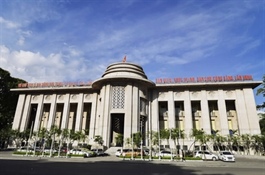Vietnam's Central Bank cuts policy rate for third time
Vietnam's Central Bank cuts policy rate for third time
The aim is to steer the market towards a downward trend in interest rates in the future by lowering the ceiling on deposit and operating rates.
 |
The State Bank of Vietnam (SBV), the country’s central bank, has announced its decision to cut the policy rates for thethird time in 2023, scheduled to take effect on May 25.

Bank's staff at the BIDV-Hoan Kiem branch changes the lending rates. Photo: Pham Hung/The Hanoi Times |
As a result, overnight loans and rediscounts for interbank electronic payments and loans to cover payment settlement shortfalls between credit institutions and the SBV have been reduced from 6.0% per annum to 5.5% per annum.
The refinancing rate was reduced from 5.5% to 5.0% per annum, while the rediscount rate remained unchanged at 3.5% per annum.
The SBV noted that the maximum interest rate for sight deposits and deposits with a maturity of less than one month would remain at 0.5% per annum. However, the maximum interest rate for deposits with a maturity of up to six months has been reduced from 5.5% to 5.0% per annum.
In special cases, such as deposits in Vietnamese dong (VND) in People's Credit Funds and Microfinance Institutions, the maximum interest rate will be reduced from 6.0% to 5.5% per annum. Credit institutions will set interest rates for deposits with a maturity of six months or more based on market capital supply and demand.
Previously, the State Bank of Vietnam had made two interest rate adjustments in March and April, cutting rates by 0.5-1% per year to support the economy.
The central bank also instructed credit institutions to maintain stable and reasonable deposit rates in line with their capital adequacy, healthy credit expansion, and risk management capacity.
The aim is to ensure that these rates do not disrupt the stability of the money market and market interest rates. In addition, credit institutions are encouraged to reduce costs to stabilize lending rates and support enterprises in their recovery and development of production and business activities.
The SBV suggested that the interest rate level has remained relatively stable, with market rates gradually decreasing in the first month of 2023. Commercial banks' average new deposit interest rate is 6.3% per year, a decrease of 0.18% per year compared to the end of 2022. In addition, the VND lending interest rate at commercial banks is about 9.3% per year, a decrease of 0.65% per year compared to the end of 2022.
The SBV attributes the persistence of high lending interest rates to various factors, such as the economy's heavy reliance on capital supply channels from the banking system and domestic and international pressures on inflation and exchange rates.
Data showed that the credit-to-GDP ratio reached 125.34% at the end of 2022, while the economy's continuous demand for capital has put pressure on lending rates.
The SBV added that Vietnam's significant economic openness, where fluctuations in the financial market and world currencies have a strong and rapid impact on domestic interest rates and exchange rates, remains another key factor influencing interest rates.






















